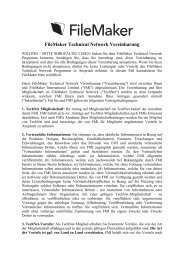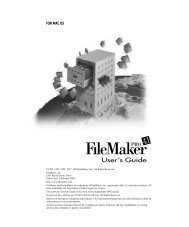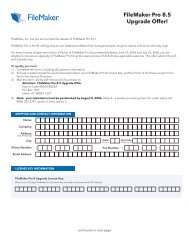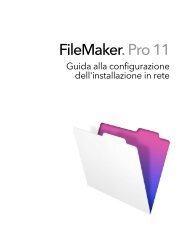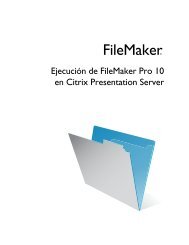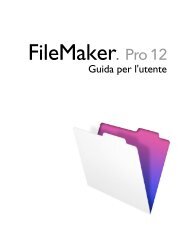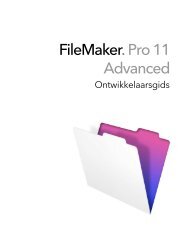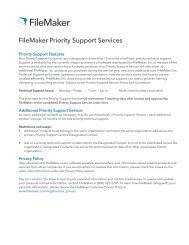Network Install Setup for FileMaker Pro 10 and
Network Install Setup for FileMaker Pro 10 and
Network Install Setup for FileMaker Pro 10 and
You also want an ePaper? Increase the reach of your titles
YUMPU automatically turns print PDFs into web optimized ePapers that Google loves.
<strong>FileMaker</strong> ® <strong>Pro</strong> <strong>10</strong><br />
<strong>Network</strong> <strong>Install</strong> <strong>Setup</strong> Guide
© 2005-2009 <strong>FileMaker</strong>, Inc. All rights reserved.<br />
<strong>FileMaker</strong>, Inc.<br />
5201 Patrick Henry Drive<br />
Santa Clara, Cali<strong>for</strong>nia 95054<br />
<strong>FileMaker</strong>, the file folder logo, Bento <strong>and</strong> the Bento logo are<br />
either trademarks or registered trademarks of <strong>FileMaker</strong>, Inc. in<br />
the U.S. <strong>and</strong> other countries. Mac <strong>and</strong> the Mac logo are the<br />
property of Apple Inc. registered in the US <strong>and</strong> other countries.<br />
All other trademarks are the property of their respective owners.<br />
<strong>FileMaker</strong> documentation is copyrighted. You are not authorized<br />
to make additional copies or distribute this documentation<br />
without written permission from <strong>FileMaker</strong>. You may use this<br />
documentation solely with a valid licensed copy of <strong>FileMaker</strong><br />
software.<br />
All persons, companies, email addresses, <strong>and</strong> URLs listed in the<br />
examples are purely fictitious <strong>and</strong> any resemblance to existing<br />
persons, companies, email addresses or URLs is purely<br />
coincidental. Credits are listed in the Acknowledgements<br />
documents provided with this software. Mention of third-party<br />
products <strong>and</strong> URLs are <strong>for</strong> in<strong>for</strong>mational purposes only <strong>and</strong><br />
constitutes neither an endorsement nor a recommendation.<br />
<strong>FileMaker</strong>, Inc. assumes no responsibility with regard to the<br />
per<strong>for</strong>mance of these products.<br />
For more in<strong>for</strong>mation, visit our website at www.filemaker.com.<br />
Edition: 01<br />
U08506-002A
Contents<br />
Preface 5<br />
Be<strong>for</strong>e you begin 5<br />
Step 1. Find the license key 5<br />
Step 2. Copy the installation files to a networked volume 5<br />
Step 3. Determine how personalized in<strong>for</strong>mation will be entered 6<br />
About installing Bonjour (Windows) 6<br />
Setting up assisted installations 7<br />
<strong>Install</strong>ing from the comm<strong>and</strong> line (Windows) 7<br />
Setting up silent assisted installations (Windows) 8<br />
Modifying <strong>Setup</strong>.ini <strong>for</strong> silent installation (Windows) 8<br />
Per<strong>for</strong>ming a silent installation using the comm<strong>and</strong> line (Windows) 8<br />
Setting up an MSI trans<strong>for</strong>m (Windows) 9<br />
About the personalization file <strong>10</strong><br />
Setting personalization properties 11
4 <strong>FileMaker</strong> <strong>Pro</strong> <strong>Network</strong> <strong>Install</strong> <strong>Setup</strong> Guide
Preface<br />
Preface 5<br />
This document explains how to configure the installation of <strong>FileMaker</strong> ® <strong>Pro</strong> or <strong>FileMaker</strong> <strong>Pro</strong> Advanced<br />
over a network.<br />
For in<strong>for</strong>mation about the products or to install single copies, see the <strong>Install</strong>ation <strong>and</strong> New Features Guide.<br />
PDF documentation comes with the electronic download <strong>and</strong> the product CD. You can also access electronic<br />
documentation in the following ways:<br />
1 In <strong>FileMaker</strong> <strong>Pro</strong> or <strong>FileMaker</strong> <strong>Pro</strong> Advanced, choose Help menu > <strong>Pro</strong>duct Documentation, then choose<br />
the document you want from the submenu.<br />
1 On the web, go to www.filemaker.com/documentation.<br />
Your electronic download or CD contains <strong>FileMaker</strong> product installers <strong>for</strong> Windows <strong>and</strong> the Mac OS. All<br />
use of this software is subject to the terms of your license agreement.<br />
Be<strong>for</strong>e you begin<br />
Be<strong>for</strong>e you configure your installation, do the following:<br />
Step 1. Find the license key<br />
You must enter the 35-digit alphanumeric license key to install the software. If you paid <strong>for</strong> your software<br />
electronically, you received an email message with a link to a PDF file with your license key. If you have a<br />
product CD, the license key is on the back of the CD sleeve.<br />
Important If you purchased a Volume License or Site License, the license key is customized <strong>for</strong> your<br />
organization. When installing software, enter the organization name exactly as it appears on your license<br />
agreement (“<strong>Pro</strong>of of License”). The organization name must be capitalized the same way it appears on your<br />
agreement.<br />
Step 2. Copy the installation files to a networked volume<br />
To make <strong>FileMaker</strong> installation files available on your network:<br />
1. Create a folder on a networked volume <strong>for</strong> the <strong>FileMaker</strong> installer files.<br />
2. Locate the following files on the electronic download or product CD <strong>and</strong> copy them to the folder you<br />
created on your networked volume:<br />
1 Windows: The Files folder, which contains the personalization file (Assisted <strong>Install</strong>.txt) <strong>and</strong> other<br />
required installation files.<br />
1 Mac OS: The <strong>FileMaker</strong> <strong>Pro</strong> or <strong>FileMaker</strong> <strong>Pro</strong> Advanced installer application <strong>and</strong> the personalization<br />
file (Assisted <strong>Install</strong>.txt), which are located at the root level of the CD.<br />
Note If you share the electronic download or CD over the network rather than copying installation files to<br />
a networked volume, only one installer will be available—the installer <strong>for</strong> the plat<strong>for</strong>m of the machine<br />
running the CD. If you share the CD over the network, you can’t use a personalization file. See “About the<br />
personalization file” on page <strong>10</strong>.
6 <strong>FileMaker</strong> <strong>Pro</strong> <strong>Network</strong> <strong>Install</strong> <strong>Setup</strong> Guide<br />
Step 3. Determine how personalized in<strong>for</strong>mation will be entered<br />
There are five ways to enter personalized in<strong>for</strong>mation (such as user name, license key, <strong>and</strong> organization<br />
name) <strong>and</strong> set installation options.<br />
Important Use a single method <strong>for</strong> entering all personalization in<strong>for</strong>mation <strong>and</strong> installation options. To<br />
avoid conflicts, do not combine methods. For example, do not enter the user name in the personalization<br />
file, <strong>and</strong> the organization name in the comm<strong>and</strong> line.<br />
1 You can set up an assisted installation, which uses a personalization file named Assisted <strong>Install</strong>.txt to<br />
supply in<strong>for</strong>mation to the installer <strong>and</strong> st<strong>and</strong>ardize all networked <strong>FileMaker</strong> <strong>Pro</strong> or <strong>FileMaker</strong> <strong>Pro</strong><br />
Advanced installations. This method lets you customize the installation, <strong>and</strong> eliminates the need to<br />
distribute <strong>and</strong> administer license keys. <strong>FileMaker</strong>, Inc. recommends this method. See “Setting up assisted<br />
installations” on page 7.<br />
1 (Windows) Users can enter the personalization in<strong>for</strong>mation at the comm<strong>and</strong> line. See “<strong>Install</strong>ing from the<br />
comm<strong>and</strong> line (Windows)” on page 7.<br />
1 (Windows) You can set up a silent assisted installation. User interaction with the <strong>FileMaker</strong> installer is<br />
kept to a minimum. The installer reads personalization in<strong>for</strong>mation from the personalization file <strong>and</strong><br />
installation screens do not display. See “Setting up silent assisted installations (Windows)” on page 8.<br />
1 (Windows) You can set up an MSI trans<strong>for</strong>m that can be applied to the Windows installer. The changes<br />
persist in your installer image. You don’t have to edit the personalization file <strong>and</strong> can remove it from the<br />
installer. See “Setting up an MSI trans<strong>for</strong>m (Windows)” on page 9.<br />
1 Users can personalize the software by entering their in<strong>for</strong>mation when the installer prompts <strong>for</strong> it in full<br />
user interface mode.<br />
Notes<br />
1 Users must have Administrator privileges to install <strong>FileMaker</strong> <strong>Pro</strong> or <strong>FileMaker</strong> <strong>Pro</strong> Advanced.<br />
1 On Mac OS, the installer installs the <strong>FileMaker</strong> product to use the same language as the current Mac OS<br />
system language. Users who want to install the <strong>FileMaker</strong> product with a different language should use<br />
the International System Preference to change the Mac OS language prior to installing the <strong>FileMaker</strong><br />
product.<br />
About installing Bonjour (Windows)<br />
Bonjour service delivery protocol must be installed <strong>for</strong> databases to be broadcast <strong>and</strong> <strong>for</strong> remote databases<br />
to be detected. If Bonjour is not installed or if the Bonjour service isn’t running, users won’t be able to view<br />
hosted databases in the Open Remote File dialog box. They can manually enter IP addresses <strong>for</strong> IPv4 <strong>and</strong><br />
IPv6 <strong>and</strong> <strong>for</strong> database names.<br />
Bonjour can be installed only by using <strong>Setup</strong>.exe in full user interface mode or silent mode (not <strong>FileMaker</strong><br />
<strong>Pro</strong> <strong>10</strong>.msi or <strong>FileMaker</strong> <strong>Pro</strong> <strong>10</strong> Advanced.msi).<br />
During the setup operation, one of the following will occur:<br />
1 If Bonjour isn’t detected, the installer alerts you <strong>and</strong> prompts you to install Bonjour.
Setting up assisted installations 7<br />
1 If a previous version of Bonjour is detected, the installer alerts you. It prompts you to manually uninstall<br />
the older version of Bonjour <strong>and</strong> manually install the version of Bonjour supported by <strong>FileMaker</strong>.<br />
1 If the same or a later version of Bonjour is detected, the installer does not alert you <strong>and</strong> does not install<br />
Bonjour.<br />
You can also install Bonjour manually. Open the Bonjour folder (located at the same level as <strong>Setup</strong>.exe),<br />
open the 32-bit or 64-bit folder, <strong>and</strong> then launch Bonjour<strong>Setup</strong>.exe.<br />
Setting up assisted installations<br />
1. Set up a networked volume so that users can install <strong>FileMaker</strong> products <strong>for</strong> Windows <strong>and</strong> the Mac OS.<br />
See “Step 2. Copy the installation files to a networked volume” on page 5.<br />
2. Edit the personalization file, Assisted <strong>Install</strong>.txt. See “About the personalization file” on page <strong>10</strong>.<br />
To install <strong>FileMaker</strong> <strong>Pro</strong> or <strong>FileMaker</strong> <strong>Pro</strong> Advanced, instruct users to:<br />
1. Mount the volume containing the installation files.<br />
2. Double-click <strong>Setup</strong>.exe (Windows) or the <strong>FileMaker</strong> <strong>Pro</strong> or <strong>FileMaker</strong> <strong>Pro</strong> Advanced installer<br />
application (Mac OS).<br />
3. Windows XP <strong>and</strong> Windows Vista users will see the Open File – Security Warning dialog box. Click Run<br />
to continue installing.<br />
If Assisted <strong>Install</strong>.txt is present in the same folder as the installer, the installer uses in<strong>for</strong>mation in it during<br />
installation. If this file is not present or is incomplete, users must supply required in<strong>for</strong>mation.<br />
<strong>Install</strong>ing from the comm<strong>and</strong> line (Windows)<br />
Users can install <strong>FileMaker</strong> products from the comm<strong>and</strong> line without editing the Assisted <strong>Install</strong>.txt file. A<br />
comm<strong>and</strong> line install requires you to run the Comm<strong>and</strong> <strong>Pro</strong>mpt as administrator.<br />
1. In Windows, choose Start menu > All <strong>Pro</strong>grams > Accessories.<br />
2. Right-click Comm<strong>and</strong> <strong>Pro</strong>mpt, then choose Run As (Windows XP) or Run as administrator<br />
(Windows Vista).<br />
3. Windows XP: In the Run As dialog box, select Administrator, enter the password, then click OK.<br />
Windows Vista: In the Administrator:Comm<strong>and</strong> <strong>Pro</strong>mpt window, enter a comm<strong>and</strong>.<br />
For example:<br />
msiexec -i "<strong>FileMaker</strong> <strong>Pro</strong>.msi" AI_USERNAME="John Lee"<br />
AI_ORGANIZATION="<strong>FileMaker</strong>, Inc." AI_LICENSEKEY=12345-12345-12345-12345-<br />
12345-12345-12345<br />
The property names must be capitalized. For more in<strong>for</strong>mation, see “Setting personalization properties” on<br />
page 11.
8 <strong>FileMaker</strong> <strong>Pro</strong> <strong>Network</strong> <strong>Install</strong> <strong>Setup</strong> Guide<br />
Setting up silent assisted installations (Windows)<br />
During a silent installation, user interaction with the <strong>FileMaker</strong> installer is kept to a minimum. Required<br />
installation in<strong>for</strong>mation is read from the personalization file (Assisted <strong>Install</strong>.txt) <strong>and</strong> installation screens are<br />
not displayed. For in<strong>for</strong>mation about setting up Assisted <strong>Install</strong>.txt, see “About the personalization file” on<br />
page <strong>10</strong>.<br />
There are two ways to per<strong>for</strong>m a silent installation. Users can:<br />
1 Double-click the <strong>Setup</strong>.exe file located on the mounted volume. This method requires that you modify<br />
the <strong>Setup</strong>.ini file. For more in<strong>for</strong>mation, see the next section.<br />
1 Type the installation comm<strong>and</strong> <strong>and</strong> applicable options at the comm<strong>and</strong> line. For more in<strong>for</strong>mation, see<br />
“Per<strong>for</strong>ming a silent installation using the comm<strong>and</strong> line (Windows)” on page 8.<br />
Modifying <strong>Setup</strong>.ini <strong>for</strong> silent installation (Windows)<br />
1. Locate the <strong>Setup</strong>.ini file in the Files folder inside the <strong>FileMaker</strong> <strong>Pro</strong> or <strong>FileMaker</strong> <strong>Pro</strong> Advanced folder.<br />
2. Open <strong>Setup</strong>.ini using a text editor such as Notepad.<br />
3. Locate the [Startup] section <strong>and</strong> type one of the following after CmdLine=<br />
To Add the options as shown after CmdLine=<br />
<strong>Install</strong> a <strong>FileMaker</strong> product without a user interface (silent install) CmdLine=/q<br />
Display a progress bar <strong>and</strong> Cancel button during installation CmdLine=/qb+<br />
<strong>Install</strong> <strong>FileMaker</strong> <strong>Pro</strong> or <strong>FileMaker</strong> <strong>Pro</strong> Advanced to a non-default<br />
location on the local machine<br />
Note <strong>Install</strong>path is the desired location of the <strong>FileMaker</strong> product folder on the user’s computer. The path<br />
cannot contain spaces unless it is enclosed by quotation marks. The following example path would install<br />
into the <strong>FileMaker</strong><strong>Pro</strong><strong>10</strong> folder inside the Applications folder on drive C:<br />
C:\Applications\<strong>FileMaker</strong><strong>Pro</strong><strong>10</strong><br />
4. Save <strong>and</strong> close the <strong>Setup</strong>.ini file.<br />
5. Instruct users to double-click the <strong>Setup</strong>.exe file located on the mounted volume.<br />
Per<strong>for</strong>ming a silent installation using the comm<strong>and</strong> line (Windows)<br />
Users can install <strong>FileMaker</strong> products from the comm<strong>and</strong> line. When you use this method, the installer can<br />
in<strong>for</strong>m users whether installation was successful.<br />
A comm<strong>and</strong> line silent install requires you to run the Comm<strong>and</strong> <strong>Pro</strong>mpt as administrator.<br />
1. In Windows, choose Start menu > All <strong>Pro</strong>grams > Accessories.<br />
CmdLine=/qb+ INSTALLDIR=installpath<br />
2. Right-click Comm<strong>and</strong> <strong>Pro</strong>mpt, then choose Run As (Windows XP) or Run as administrator<br />
(Windows Vista).<br />
3. Windows XP: In the Run As dialog box, select Administrator, enter the password, then click OK.<br />
Windows Vista: In the Administrator:Comm<strong>and</strong> <strong>Pro</strong>mpt window, enter a comm<strong>and</strong>.
Setting up an MSI trans<strong>for</strong>m (Windows) 9<br />
The following table describes options users have when per<strong>for</strong>ming an assisted installation from the<br />
comm<strong>and</strong> line.<br />
To Instruct users to open a comm<strong>and</strong> window, then type<br />
<strong>Install</strong> a <strong>FileMaker</strong> product without a user interface (silent<br />
install)<br />
Uninstall a <strong>FileMaker</strong> product without a user interface<br />
(silent uninstall)<br />
<strong>Install</strong> a <strong>FileMaker</strong> product when required — advertise to<br />
current user (silent advertised install)<br />
<strong>Install</strong> a <strong>FileMaker</strong> product when required — advertise to<br />
all users (silent advertised install)<br />
Display a dialog box indicating whether the <strong>FileMaker</strong><br />
product was successfully installed<br />
Notes<br />
1 Pathname is the location of the installer directory you created on the networked volume.<br />
1 <strong>Install</strong>path is the desired location of the <strong>FileMaker</strong> product folder on the user’s computer. The path<br />
cannot contain spaces unless it is enclosed by quotation marks.<br />
1 The installer may reboot the computer if required.<br />
Setting up an MSI trans<strong>for</strong>m (Windows)<br />
"pathname\setup.exe" /s /v/qn<br />
"pathname\setup.exe" /s /x /v/qn<br />
"pathname\setup.exe" /s /v /ju<br />
"pathname\setup.exe" /s /v /jm<br />
"pathname\setup.exe" /s /v/qn+<br />
Display a progress bar <strong>and</strong> cancel button during installation "pathname\setup.exe" /s /v/qb+<br />
<strong>Install</strong> <strong>FileMaker</strong> <strong>Pro</strong> to a non-default location on your<br />
local machine<br />
<strong>Install</strong> <strong>FileMaker</strong> <strong>Pro</strong> Advanced to a non-default location<br />
on your local machine<br />
"pathname\setup.exe" /s /v"/qb+<br />
INSTALLDIR=\"installpath\<strong>FileMaker</strong> <strong>Pro</strong> <strong>10</strong>\""<br />
"pathname\setup.exe" /s /v"/qb+<br />
INSTALLDIR=\"installpath\<strong>FileMaker</strong> <strong>Pro</strong> <strong>10</strong> Advanced\""<br />
You can use an MSI trans<strong>for</strong>m (*.mst file) to provide personalization in<strong>for</strong>mation to the installer. For<br />
in<strong>for</strong>mation about Orca, MsiTran.exe, <strong>and</strong> other Windows installer development tools, see<br />
www.microsoft.com.<br />
1. Create a copy of the <strong>FileMaker</strong> <strong>Pro</strong>.msi file. For example, name the copy <strong>FileMaker</strong> <strong>Pro</strong> Assisted<br />
<strong>Install</strong>.msi.<br />
2. Use Orca (or similar software) to edit <strong>FileMaker</strong> <strong>Pro</strong> Assisted <strong>Install</strong>.msi. Set the personalization<br />
properties (AI_*) in the <strong>Pro</strong>perty table.<br />
See “Setting personalization properties” on page 11.<br />
3. Use an MSI trans<strong>for</strong>m generating tool, like MsiTran.exe, to create a trans<strong>for</strong>m. For example, to create a<br />
trans<strong>for</strong>m named Example.mst, type:<br />
msitran.exe -g "<strong>FileMaker</strong> <strong>Pro</strong>.msi" "<strong>FileMaker</strong> <strong>Pro</strong> Assisted <strong>Install</strong>.txt"<br />
Example.mst
<strong>10</strong> <strong>FileMaker</strong> <strong>Pro</strong> <strong>Network</strong> <strong>Install</strong> <strong>Setup</strong> Guide<br />
4. Apply the trans<strong>for</strong>m to the installer. For example:<br />
msitran.exe -a Example.mst "<strong>FileMaker</strong> <strong>Pro</strong>.msi"<br />
5. Instruct users to run the installer using the comm<strong>and</strong> line, or by double-clicking the <strong>Setup</strong>.exe file located<br />
on the mounted volume.<br />
About the personalization file<br />
An assisted installation eases installation of <strong>FileMaker</strong> <strong>Pro</strong> or <strong>FileMaker</strong> <strong>Pro</strong> Advanced in a multiple<br />
computer environment. You enter in<strong>for</strong>mation (such as a generic user name, organization name, license key,<br />
<strong>and</strong> installation options) in a personalization file, <strong>and</strong> then make the file available on your network.<br />
The personalization file, Assisted <strong>Install</strong>.txt, is used by the <strong>FileMaker</strong> installers to install <strong>FileMaker</strong> <strong>Pro</strong> or<br />
<strong>FileMaker</strong> <strong>Pro</strong> Advanced on computers in your organization. The file is identical on Windows <strong>and</strong> Mac OS.<br />
To edit the personalization file:<br />
1. Use a text editor such as Notepad (Windows) or TextEdit (Mac OS) to open the Assisted <strong>Install</strong>.txt file<br />
on your networked volume.<br />
2. Edit the personalization file. See “Setting personalization properties” on page 11.<br />
3. Save the changes you have made to Assisted <strong>Install</strong>.txt as plain text.<br />
1 Windows: Assisted <strong>Install</strong>.txt <strong>and</strong> <strong>Setup</strong>.exe must be in the Files folder during installation.<br />
1 Mac OS: Assisted <strong>Install</strong>.txt must be in the same folder as the <strong>FileMaker</strong> <strong>Pro</strong> or <strong>FileMaker</strong> <strong>Pro</strong><br />
Advanced installer application during installation.<br />
Windows: Be<strong>for</strong>e <strong>FileMaker</strong> <strong>Pro</strong> 7, the personalization file was named <strong>FileMaker</strong> <strong>Pro</strong> x.pdf. This file still<br />
exists <strong>and</strong> is required <strong>for</strong> an assisted installation, but you should not edit this file. The file is used by<br />
Microsoft SMS.
Setting personalization properties<br />
About the personalization file 11<br />
This section explains the properties <strong>and</strong> variables in the personalization file, Assisted <strong>Install</strong>.txt.<br />
Note <strong>Pro</strong>perty names (AI_*) must be capitalized. Variable settings are not case-sensitive, except <strong>for</strong><br />
organization names. (See the description <strong>for</strong> AI_ORGANIZATION.)<br />
To Do this<br />
Enter a user name <strong>for</strong> all installations Type a name after AI_USERNAME=<br />
If you leave this variable blank, the installer defaults to the name that was used to register<br />
Windows (Windows) or the account user name (Mac OS).<br />
Enter a company name <strong>for</strong> all<br />
installations<br />
Enter a valid license key <strong>for</strong> all<br />
installations<br />
Windows: Specify the language<br />
version of the <strong>FileMaker</strong> product. This<br />
setting only works when users per<strong>for</strong>m<br />
a silent assisted installation. See<br />
“Setting up silent assisted installations<br />
(Windows)” on page 8.<br />
Windows: Specify whether the<br />
<strong>FileMaker</strong> product is available to all<br />
users or to the current user only<br />
Prevent or allow users to create new<br />
databases<br />
Windows: Create a shortcut <strong>for</strong> the<br />
<strong>FileMaker</strong> product on the desktop <strong>and</strong><br />
in the Quick Launch toolbar<br />
Suppress or display electronic<br />
registration<br />
Type a name after AI_ORGANIZATION=<br />
If you purchased a Volume License or Site License, type the organization name exactly as<br />
it appears on your license agreement (“<strong>Pro</strong>of of License”). The organization name must<br />
be capitalized the same way it appears on your agreement.<br />
Windows: If you leave this variable blank, the installer defaults to the name that was used<br />
to register Windows.<br />
Type your license key after AI_LICENSEKEY=<br />
For in<strong>for</strong>mation about the license key, see “Step 1. Find the license key” on page 5.<br />
Type the name of the language after AI_LANGUAGE=<br />
Valid entries are: Dutch, English, French, German, Italian, Japanese, SimplifiedChinese,<br />
Spanish, Swedish, or TraditionalChinese.<br />
Mac OS: Do not specify a language setting. The <strong>FileMaker</strong> installer uses the current<br />
language setting from your operating system.<br />
Type one of the following after AI_APPLICATIONUSERS=<br />
1 AllUsers to make the <strong>FileMaker</strong> product available to any user logged in on this<br />
computer<br />
1 OnlyCurrentUser to restrict use of the <strong>FileMaker</strong> product to the user account that is<br />
logged on during installation<br />
Type one of the following after AI_NONEWDATABASES=<br />
1 1 (one) to prevent users from creating databases<br />
1 0 (zero) to allow users to create databases<br />
For more in<strong>for</strong>mation, see “Preventing users from creating databases” on page 12.<br />
Type one of the following after AI_SHORTCUTS=<br />
1 1 (one) to create a shortcut<br />
1 0 (zero) if you don’t want to create a shortcut<br />
See the note at the end of this table <strong>for</strong> more in<strong>for</strong>mation.<br />
Type one of the following after AI_REGISTRATION=<br />
1 0 (zero) to suppress electronic registration. Your <strong>FileMaker</strong> product won’t prompt<br />
users to enter registration in<strong>for</strong>mation.<br />
1 1 (one) to display an electronic registration reminder
12 <strong>FileMaker</strong> <strong>Pro</strong> <strong>Network</strong> <strong>Install</strong> <strong>Setup</strong> Guide<br />
To Do this<br />
Suppress or display the<br />
personalization dialog box during<br />
installation<br />
Disable or enable the Update<br />
Notification dialog box during<br />
installation<br />
Note The AI_SHORTCUTS <strong>and</strong> AI_SKIPDIALOG properties determine whether the installer prompts the<br />
user to create a shortcut (Windows).<br />
Preventing users from creating databases<br />
You can set a property, AI_NONEWDATABASES, that prevents users from creating <strong>FileMaker</strong> databases.<br />
If the option is set, the <strong>FileMaker</strong> product displays an alert message when users do the following:<br />
1 Choose File menu > New Database.<br />
1 Create a database from the <strong>FileMaker</strong> Quick Start Screen.<br />
1 Export to a <strong>FileMaker</strong> <strong>Pro</strong> file.<br />
1 Choose File menu > Save a Copy As.<br />
1 Open the New Database dialog box.<br />
1 Recover a <strong>FileMaker</strong> <strong>Pro</strong> file.<br />
1 Convert another file <strong>for</strong>mat (like tab-delimited) into a new <strong>FileMaker</strong> <strong>Pro</strong> file, <strong>for</strong> example, by choosing<br />
File menu > Open.<br />
1 Execute an Apple event to open a file in another <strong>for</strong>mat.<br />
1 Execute the Apple events do menu comm<strong>and</strong> to create a file.<br />
1 Per<strong>for</strong>m a script that does any of the above.<br />
1 Choose a custom menu item that does any of the above.<br />
Type one of the following after AI_SKIPDIALOG=<br />
1 1 (one) to suppress the personalization dialog box. Users don’t have to enter a name or<br />
organization, <strong>and</strong> they don’t see the license key. (If the key you entered is invalid, the<br />
personalization dialog box displays.)<br />
1 0 (zero) to display the personalization dialog box during installation<br />
See the note after this table <strong>for</strong> more in<strong>for</strong>mation.<br />
AI_SHORTCUTS= AI_SKIPDIALOG= Result<br />
Type one of the following after AI_DISABLEUPDATENOTIFY=<br />
1 1 (one) to disable the Update Notification dialog box. Users will not be notified when<br />
a software update is available. In addition, the following items will not be available in<br />
the <strong>FileMaker</strong> product: Help menu > Downloads <strong>and</strong> Updates <strong>and</strong> the General<br />
Preferences option.<br />
1 0 (zero) to enable the Update Notification dialog box. Users will be notified at startup<br />
when a software update is available. This is the default setting.<br />
For more in<strong>for</strong>mation on update notification, see the <strong>Install</strong>ation <strong>and</strong> New Features<br />
Guide.<br />
1 1 No prompt. Creates shortcut<br />
0 1 No prompt. Doesn’t create shortcut<br />
1 0 <strong>Pro</strong>mpt<br />
0 0 <strong>Pro</strong>mpt<br />
To create databases, users must reinstall the <strong>FileMaker</strong> software with the AI_NONEWDATABASES<br />
variable set to 0.



